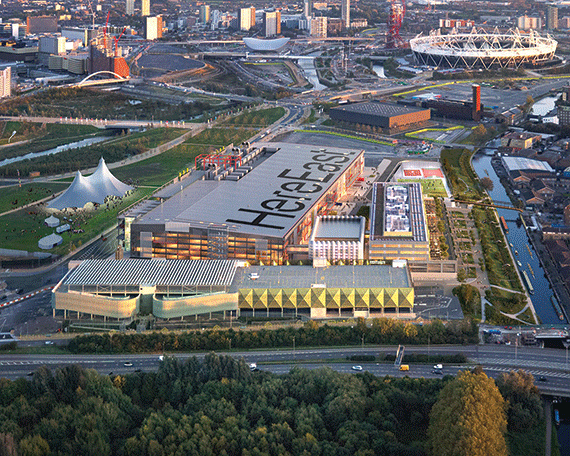Here East: home for the internet industrialists
News
by
Janie Manzoori-Stamford
Built to house more than 20,000 journalists covering the 2012 Olympic Games in Stratford, E20, Here East, as the Olympic Press and Broadcast Centre is now known, has set its sights on becoming a hub for the next generation of tech occupiers: the internet industrialists.
Some 18 months from completion, the Delancey-led redevelopment of the Press and Broadcast Centre is 55% let by floorspace and Gavin Poole – the man behind the ambitious plan to steal some tech thunder from the EC1 homeland – is feeling confident.
Built to house more than 20,000 journalists covering the 2012 Olympic Games in Stratford, E20, Here East, as the Olympic Press and Broadcast Centre is now known, has set its sights on becoming a hub for the next generation of tech occupiers: the internet industrialists.
Some 18 months from completion, the Delancey-led redevelopment of the Press and Broadcast Centre is 55% let by floorspace and Gavin Poole – the man behind the ambitious plan to steal some tech thunder from the EC1 homeland – is feeling confident.
“This is so unique that we’re not really worried about competition, to be honest,” says the Here East chief executive. “That’s not an arrogant point of view. We’re on the Olympic Park. It’s a unique destination, a unique development, a unique vision.”
He’s not wrong. While Here East may not be the only London development targeting the growing tech sector, it is by far the biggest. At 1.2m sq ft – the equivalent of almost 90 Olympic-sized swimming pools – Here East has the capacity to support more than 5,500 jobs and to pump more than £340m into the local economy.
It has already secured data centre operator Infinity SDC as a tenant. Broadcaster BT Sport is there already, while visual arts organisation SPACE Studios and dance studio Wayne McGregor have also committed to taking space in the campus.
Poole has ambitions to make Here East the centre of the tech universe not for the coders, but for the makers, for the internet industrialists manufacturing the products and services of the future.
He sees Here East as a place where “serious” products – broadcast content, robotics, wearable technology and software – can be developed.
Central to this ambition is collaboration, says Poole, who this week announced that a new Technology Innovation Centre is to be developed at the project.
The TIC, a jv between Delancey fund DV4 and ENTIQ, the team behind Canary Wharf fintech accelerator Level39, will occupy 68,000 sq ft on the ground floor of the former Olympic Press Centre.
At full capacity the TIC will support as many as 500 on-site members and organisations that will have access to accelerator and incubation programmes, prototyping facilities and a state-of-the-art technology lab, designed to support new product development, business growth and collaboration.
Prior to the Here East offer, internet industrialists often took space in whatever properties they could get their hands on, space that was often at the end of its use and ready to be redeveloped, Poole says.
“Those sorts of spaces were great for those businesses when they were start-ups, but a lot of companies talking to us say it is time to get serious and find a proper, permanent home,” he says.
Laurence Kemball-Cook, founder of Pavegen, a floor tile that uses kinetic energy from footfall to generate off-grid electricity and store and analyse data, agrees.
“I started my company six years ago out of my bedroom, which is where I spent another three years working on it,” says Kemball-Cook.
“When we went to a collaboration incubator, it was pivotal to our growth. Innovation is not a linear process. You’ve got to be like a sponge and work with as many people as you can.”
For Poole, the best way to ensure a strong sense of collaboration is careful curation of tenant mix, which he says he not only has the luxury of doing but believes is critical to the development’s success.
“We’ve had people wanting to take the entire building and we said no because it skews the vision,” he says. “We threw out quite a wide net when it came to our preferred tenants and that is where the innovation is, that idea of sharing.
“If someone pitched up and said they wanted to stick all their back-office accounting here, it wouldn’t work. We’ve been in that situation before and said no.”
It all sounds very attractive. Collaborative space, high-quality occupiers and a high-speed digital infrastructure left behind by London 2012. But it is in Stratford and, arguably, on the wrong side of the Olympic Park.
If a tech occupier wants to be close to the hedge funds and investors of Mayfair, W1, Stratford can seem a long way away. Digital connections might be almost instantaneous, but activating a face-to-face meeting could be more problematic – it takes at least 20 minutes to get to Bond Street.
The fastest route into central London begins at Stratford International, which delivers passengers to St Pancras, N1, in less than 10 minutes. But the station and Here East are on almost opposite sides of the 568-acre park and while the distance between the two is equal to the distance from Liverpool Street, EC2, to Shoreditch High Street, E1, the exposed parkland between makes it feel further.
It is an obstacle that is being dealt with. BT Sport has introduced a minibus for its staff and Here East will launch a formal corporate bus service in September, which will shuttle workers between Here East, Stratford International and Westfield from 7am until 10.30pm, stopping for pick-ups every four to seven minutes.
“There’s no denying that some people just won’t consider it [as a location],” says Matthew Glenny, senior surveyor at JLL.
“But Here East will almost certainly suit native east London tenants, people who are already based in the area. And the great thing about it is that it should be reasonably priced.”
Poole says rents will be “competitive” but refuses to commit to numbers.
Glenny adds: “It also sits in an area that’s very popular with millennials. When you’ve got a younger business with people under the age of 30 living in London, a lot of them will be living in east London. Here East is seeking that kind of business and that’s got to be the right thing.”
And Poole’s confidence certainly isn’t suffering. With more than half the space already let, and more under offer and official marketing of Here East not set to begin until the end of September, it is understandable why. With expectations that the development will run out of sellable space by the summer of 2018, Here East looks set to deliver exactly the sort of post-Olympic Games gold medal story that it promised.
What is Here East?
Here East comprises the Press Centre and Broadcast Centre buildings that were home to some 20,000 journalists during the 2012 Olympics. The Press Centre comprises 251,000 sq ft of Grade A flexible offices and canal-side shops. The Broadcast Centre comprises 665,000 sq ft of creative offices, studios and shops. The scheme also includes 31,100 sq ft of auditorium and cultural events space.
Tenants
Some 55% of the 1.2m sq ft that makes up Here East has been let prior to completion of the campus in 2018. Data centre group Infinity has taken 240,000 sq ft for the development of one of the largest data centres in Europe. It will be fed by multiple power grids and will provide 42mva of power – that is 10 times the amount of power available at other developments and enough to power 2.2m simultaneous Google searches – while BT Sport has already moved into 80,000 sq ft at the site, opening Europe’s largest LED-lit studio. Dance studio Wayne McGregor is schedule to move in to 17,200 sq ft in 2017, while visual arts organisation SPACE Studio will take 10,000 sq ft.
Here East will also house a cluster of education campuses in a bid to feed its tech occupiers with fresh talent. Loughborough University has opened a 70,000 sq ft campus while University College London is taking 107,000 sq ft. The Barlett, UCL’s faculty of the built environment, and UCL Engineering will take around 30,000 sq ft of 10m- high studio space at Here East specifically for research into architecture, infrastructure, transport, robotics, healthcare, manufacturing and environmental measurement.
Key players
Developer: iCity, owned by clients of Delancey
Architect: Hawkins/Brown
Letting agents: Knight Frank, Cushman & Wakefield and CF Commercial
• To send feedback, email janie.stamford@estatesgazette.com or tweet @JanieStamford or @estatesgazette











